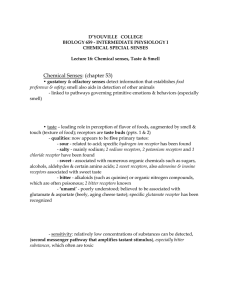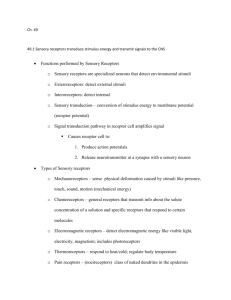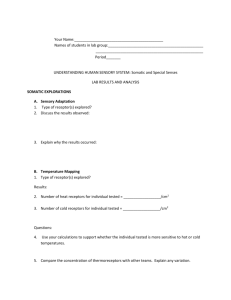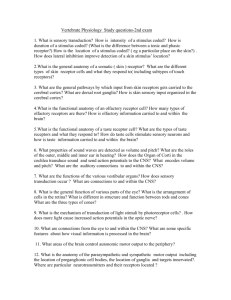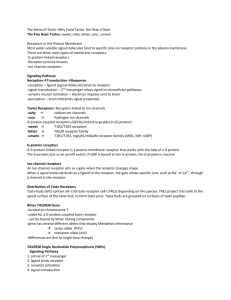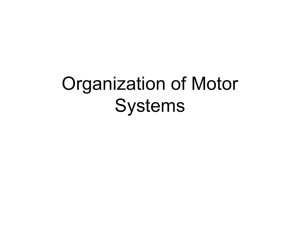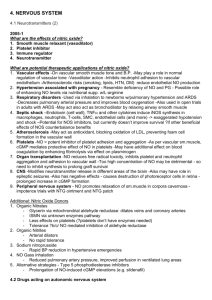Muscles & Sensory Perception Motor Unit = consists of a single
advertisement
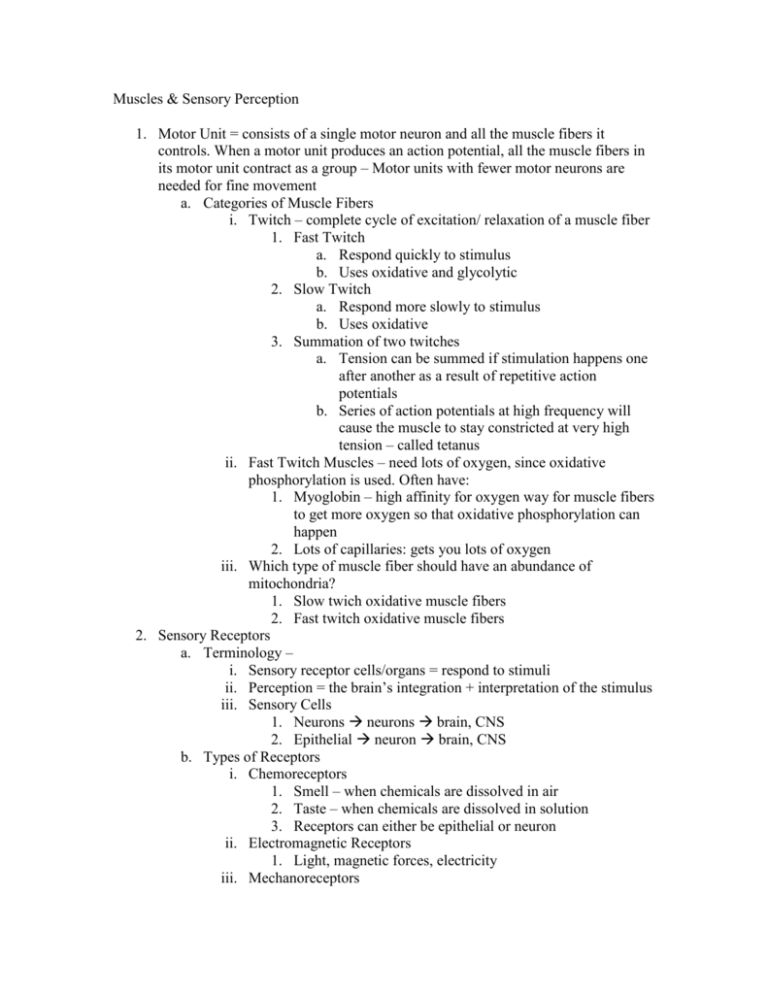
Muscles & Sensory Perception 1. Motor Unit = consists of a single motor neuron and all the muscle fibers it controls. When a motor unit produces an action potential, all the muscle fibers in its motor unit contract as a group – Motor units with fewer motor neurons are needed for fine movement a. Categories of Muscle Fibers i. Twitch – complete cycle of excitation/ relaxation of a muscle fiber 1. Fast Twitch a. Respond quickly to stimulus b. Uses oxidative and glycolytic 2. Slow Twitch a. Respond more slowly to stimulus b. Uses oxidative 3. Summation of two twitches a. Tension can be summed if stimulation happens one after another as a result of repetitive action potentials b. Series of action potentials at high frequency will cause the muscle to stay constricted at very high tension – called tetanus ii. Fast Twitch Muscles – need lots of oxygen, since oxidative phosphorylation is used. Often have: 1. Myoglobin – high affinity for oxygen way for muscle fibers to get more oxygen so that oxidative phosphorylation can happen 2. Lots of capillaries: gets you lots of oxygen iii. Which type of muscle fiber should have an abundance of mitochondria? 1. Slow twich oxidative muscle fibers 2. Fast twitch oxidative muscle fibers 2. Sensory Receptors a. Terminology – i. Sensory receptor cells/organs = respond to stimuli ii. Perception = the brain’s integration + interpretation of the stimulus iii. Sensory Cells 1. Neurons neurons brain, CNS 2. Epithelial neuron brain, CNS b. Types of Receptors i. Chemoreceptors 1. Smell – when chemicals are dissolved in air 2. Taste – when chemicals are dissolved in solution 3. Receptors can either be epithelial or neuron ii. Electromagnetic Receptors 1. Light, magnetic forces, electricity iii. Mechanoreceptors 1. Responding to mechanical stimuli like pressure, temperature, stretching, motion, sound waves iv. Theroreceptors 1. ~6 different receptors a. Heat in the range of >42ºC (108ºF) i. Also triggered by capaicin, so chili peppers are hot because they also triggered heat sensitive receptors b. Cold in the range of 8-28ºC (48-85ºF) i. Sensitive to methanol v. Pain Receptors 1. Sense pain 3. Chemoreception a. Taste i. Receptors 1. Epithelial cells that form little clusters called taste buds 2. Taste buds are somewhat recessed in the tongue a. Each taste receptor cell has a little pore that food molecules bind to b. After the signal binds to a receptor, the signal gets sent to a neuron ii. Types of Molecules we can taste (tastants) Taste Relative Sensitivity Example Salty (mineral salts) 1x NaCl, KCl Sour (acidity) 10x Vinegars, sour fruits Sweet (carbohydrates) 1x Sucrose Umami (meaty/savory) 10x Mushrooms, meat Bitter (toxins) 10,000x Caffeine, hops iii. Two types of signal transduction pathways 1. Salty/Sour a. Tastant binds to a ligand gated ion channel and then Na+ flows in and sets off action potential b. Ulimately sets off action potential at the base; response ends when the tastant leaves the ligand gated channel receptor site 2. Sweet/Bitter/Umami a. Receptor sits on the membrane of an epithelial cell b. Tastant molecule binds to its receptor and activated G protein coupled complexes, which activate an enzyme c. which results in triggering an action potential iv. After a G protein coupled receptor is triggered, the activated Gprotein will most likely : activate an enzyme b. Smell = Odorant molecules bind to specific receptor proteins in the plasma membrane of olfactory receptor cells, triggering action potential i. In olfaction, the sensory cells are neurons ii. Olfactory receptor cells line the upper portion of the nasal cavity and send impulses along their axons directly to the olfactory bulb iii. The Process 1. Odorants bind to the receptors on the plasma membrane, which are located off of cilia 2. Membrane becomes depolarized and an action potential gets sent from the olfactory bulb


